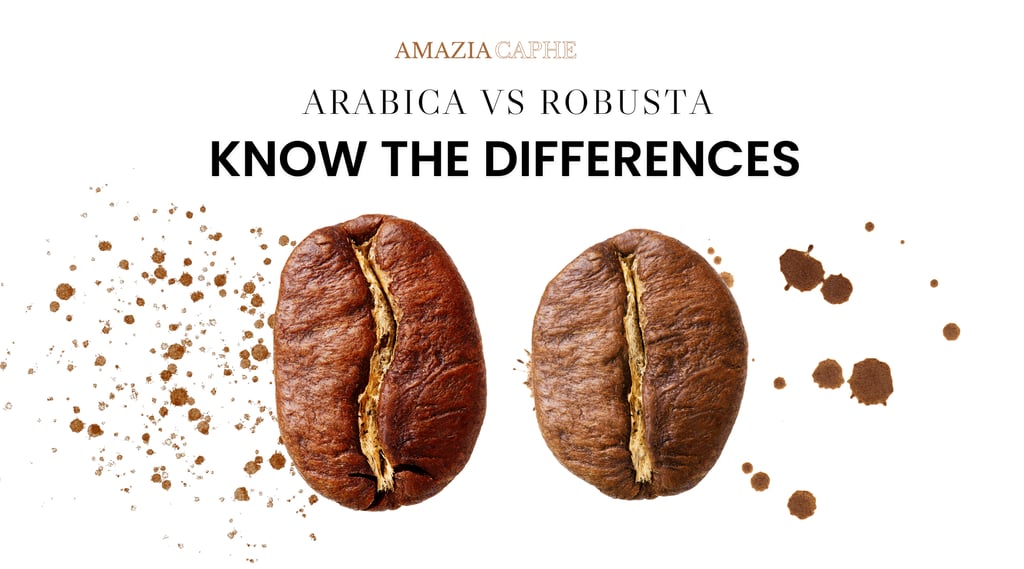Arabica vs. Robusta: Key Differences Every Coffee Lover Should Know
Discover the key differences between Arabica and Robusta coffee beans in this insightful blog post. Whether you're a seasoned coffee enthusiast or a casual drinker, understanding the unique qualities of these two popular coffee varieties can enhance your appreciation for coffee. From flavor profiles and caffeine content to growing regions and cultivation methods, we break down everything you need to know to make an informed choice next time you brew a cup.
EDUCATION


Introduction to Coffee Varieties
Coffee is one of the most consumed beverages worldwide, cherished for its rich flavor and stimulating effects. With a history that dates back centuries, it has evolved from its origins in Ethiopia to a global phenomenon, permeating various cultures and lifestyle choices. Among the diverse array of coffee options available, the two predominant varieties are Arabica and Robusta. These varieties significantly contribute to the coffee industry, representing distinct characteristics in taste, cultivation, and appeal.
Arabica coffee beans are known for their delicate flavor profile and aromatic qualities. They typically thrive in high-altitude regions, which provide the optimal climate for their growth. Arabica is primarily grown in countries such as Colombia, Brazil, and Ethiopia, where the conditions allow for slow maturation, enhancing the bean's sweetness and complexity. This variety comprises approximately 60-70% of global coffee production, making it a staple in the market.
On the other hand, Robusta beans are recognized for their strong, bold flavor and higher caffeine content. They tend to be more resilient than Arabica, flourishing in lower altitudes and harsher environments. Countries like Vietnam and Indonesia are leading producers of Robusta, which appeals to those who prefer a more robust coffee experience. Accounting for around 30-40% of global coffee production, Robusta plays a crucial role in the industry, often being used in espresso blends due to its creamy body and enhanced crema.
Understanding the distinctions and origins of Arabica and Robusta is essential for anyone interested in coffee. As consumers become increasingly discerning about their coffee choices, recognizing these key varieties allows enthusiasts and casual drinkers alike to deepen their appreciation for this beloved beverage. The exploration of these two coffee giants not only enriches the palate but also sheds light on the broader implications of coffee cultivation and consumption in the world today.
Shape and Size
Arabica Beans: Oval-shaped with a distinctive, curved "S"-shaped center crease. They are typically larger than Robusta beans.
Robusta Beans: Smaller and rounder with a straight center crease. Their compact shape is a notable contrast to Arabica beans.
Flavor Profiles and Aroma
When examining the flavor profiles and aromas of Arabica and Robusta coffee, it is evident that these two varieties present distinct characteristics that cater to different preferences among coffee enthusiasts.
Arabica: Known for its smooth, nuanced flavors with bright acidity and natural sweetness. Often exhibits fruity or floral notes, making it a preferred choice for a refined coffee experience. The aroma is fragrant, evoking memories of fruits and blossoms. The versatility of Arabica allows it to be enjoyed in various brewing methods, from pour-over to espresso, each method accentuating its unique taste.
Robusta: Offers a markedly different flavor experience. It's strong, bold flavor with earthy undertones, often described as grainy or woody. Its higher caffeine content contributes to a thicker crema and a robust, intense taste. The aroma leans toward earthy and grainy scents. Robusta's distinct flavor profile is generally less complex than that of Arabica, which might attract those who prefer a hearty cup of coffee.
The differences in flavor profiles also influence the choice of brewing methods. Arabica's pronounced acidity and sweetness lend themselves well to lighter brewing techniques that enhance its delicate notes, while Robusta’s strength holds up well in brewing practices that require a more intense extraction, such as Turkish coffee or dark roasts. When considering overall aroma, Arabica beans typically produce a fragrant bouquet that can evoke memories of fruits and blossoms, whereas Robusta’s aroma leans towards a more earthy scent, reflecting its bolder profile. Understanding these flavor distinctions allows coffee lovers to make informed decisions about which coffee best suits their personal taste preferences.
Caffeine Content and Health Benefits
The caffeine content in coffee beans plays a crucial role in their flavor profiles, health benefits, and potential side effects.
Arabica: Contains 1.2% to 1.5% caffeine, offering milder stimulation and a smoother taste. Rich in antioxidants, it provides potential health benefits such as combating oxidative stress.
Robusta: boasts a notably higher caffeine concentration, containing approximately 2.2% to 2.7% caffeine, resulting in a stronger and more bitter flavor. Its higher caffeine levels provide an intense energy boost but may lead to heightened side effects for sensitive individuals. This significant difference results in Robusta generally having a stronger, more bitter flavor profile, while Arabica is often described as smoother and more nuanced.
The higher caffeine content in Robusta not only influences its taste but also its perceived health benefits and drawbacks. Caffeine is known to enhance alertness, improve mood, and increase the metabolic rate, providing a stimulating effect on the central nervous system. Many studies suggest that moderate caffeine consumption can even be associated with potential health benefits, such as a reduced risk of certain diseases, including Parkinson’s and Alzheimer’s. However, excessive intake can lead to complications such as anxiety, restlessness, and insomnia.
While Robusta's higher caffeine levels may offer a more potent energy boost, this can also lead to heightened side effects in sensitive individuals. Conversely, Arabica, with its lower caffeine levels, might be a more suitable choice for those looking to moderate their intake while still enjoying the rich flavors of coffee. Additionally, Arabica beans typically contain more antioxidants, which are vital in combating oxidative stress, potentially leading to greater health benefits in the long run.
Ultimately, the choice between Arabica and Robusta is not only about caffeine levels but also personal preferences, tolerance, and desired health outcomes. Understanding these factors allows consumers to make informed decisions regarding their coffee consumption.
Cultivation and Economic Impact
The cultivation of Arabica and Robusta coffee is significantly influenced by a variety of environmental factors.
Arabica coffee thrives in higher altitudes, generally between 2,000 to 6,000 feet, where temperatures remain cooler, typically between 60°F and 70°F. This variety benefits from fertile volcanic soil, which contributes to its complex flavors.
Robusta coffee is hardier and more adaptable, flourishing at lower altitudes and in warmer climates, with temperatures ranging from 75°F to 85°F. Its resilience enables it to withstand harsher conditions, including diseases and pests, which poses advantages for farmers in regions with challenging environments.
However, both Arabica and Robusta growers face unique challenges that can impact their yields. Deforestation, climate change, and changing weather patterns threaten coffee production, making it crucial for farmers to adopt sustainable practices. Arabica, being more susceptible to environmental fluctuations, can experience variances in quality and quantity due to rising temperatures and irregular rainfall. In contrast, Robusta’s tougher nature may give it an edge in resilience but does not exempt it from the broader environmental crises affecting global agriculture.
The economic implications of these cultivation practices are profound. Arabica coffee generally commands a higher market price, partly due to its perceived quality and flavor complexity. Consequently, coffee-producing nations specializing in Arabica, such as Brazil and Colombia, significantly contribute to the global economy. On the other hand, Robusta, often utilized in instant coffee and blends, tends to be cheaper and is mainly cultivated in regions like Vietnam and Indonesia. These pricing dynamics shape not only local economies but also global supply chains, highlighting the importance of both varieties in maintaining a balanced coffee market.
Understanding the distinctions between Arabica and Robusta coffee is essential for appreciating the diversity and complexity of this beloved beverage. While Robusta caters to those seeking bold, intense flavors, Arabica satisfies the palate of coffee enthusiasts who value refined taste and aroma. Both varieties have unique roles in the global coffee industry, shaped by their cultivation methods, flavor profiles, and economic impact.

